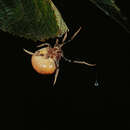en
names in breadcrumbs


Mastophora, also known as bolas spiders,[2] is a genus of orb-weaver spiders first described by E. L. Holmberg in 1876.[3] They can be identified by a pair of lumps on the dorsal surface of the opisthosoma, though not all males will have these lumps.[2]
Adult females of the genus snare prey mid-air by using a silk line with an adhesive blob on the end, similar to bolas used by South American gauchos. They feed on flying insects, particularly moths, sometimes releasing pheromones that mimic those of their prey to attract them. Males and juvenile females capture their prey directly with their legs.[4][2] Mastophora spiders have extreme sexual size dimorphism: adult females reach 0,75 inches (19 mm), while adult males are smaller than 0,067 inches (1,7 mm). These spiders reach maturity after two instars, or fewer. Cephalothorax often with dorsal protuberances, frequently paired. Female abdomen large, wider than long, an occasion has dorsal humps or lobes. Prey specialization by means of aggressive chemical mimicry.[5]
As of April 2019 it contains fifty species:[1]
Mastophora, also known as bolas spiders, is a genus of orb-weaver spiders first described by E. L. Holmberg in 1876. They can be identified by a pair of lumps on the dorsal surface of the opisthosoma, though not all males will have these lumps.
Adult females of the genus snare prey mid-air by using a silk line with an adhesive blob on the end, similar to bolas used by South American gauchos. They feed on flying insects, particularly moths, sometimes releasing pheromones that mimic those of their prey to attract them. Males and juvenile females capture their prey directly with their legs. Mastophora spiders have extreme sexual size dimorphism: adult females reach 0,75 inches (19 mm), while adult males are smaller than 0,067 inches (1,7 mm). These spiders reach maturity after two instars, or fewer. Cephalothorax often with dorsal protuberances, frequently paired. Female abdomen large, wider than long, an occasion has dorsal humps or lobes. Prey specialization by means of aggressive chemical mimicry.